Related Research Articles

The Dominican Republic is a country on the island of Hispaniola in the Greater Antilles archipelago of the Caribbean Sea, bordered by the Atlantic Ocean to the north. It occupies the eastern five-eighths of the island, which it shares with Haiti, making Hispaniola one of only two Caribbean islands, along with Saint Martin, that is shared by two sovereign states. It is the second-largest nation in the Antilles by area at 48,671 square kilometers (18,792 sq mi), and third-largest by population, with approximately 10.7 million people in 2022, of whom approximately 3.3 million live in the metropolitan area of Santo Domingo, the capital city.
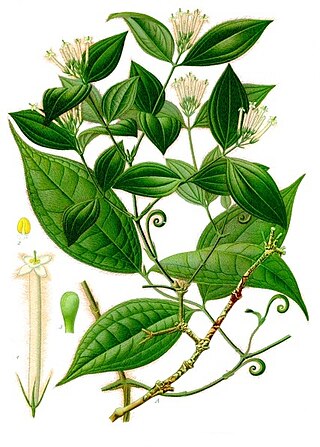
Strychnos is a genus of flowering plants, belonging to the family Loganiaceae. The genus includes about 100 accepted species of trees and lianas, and more than 200 that are as yet unresolved. The genus is widely distributed around the world's tropics and is noted for the presence of poisonous indole alkaloids in the roots, stems and leaves of various species. Among these alkaloids are the well-known and virulent poisons strychnine and curare.

Suillus is a genus of basidiomycete fungi in the family Suillaceae and order Boletales. Species in the genus are associated with trees in the pine family (Pinaceae), and are mostly distributed in temperate locations in the Northern Hemisphere, although some species have been introduced to the Southern Hemisphere.

Pimenta is a genus of flowering plants in the myrtle family, Myrtaceae described as a genus in 1821. It is native to Central and South America, Mexico, and the West Indies.

The Hispaniolan solenodon, also known as the agouta, is a small, furry, shrew-like mammal endemic to the Caribbean island of Hispaniola. Like other solenodons, it is a venomous, insect-eating animal that lives in burrows and is active at night. It is an elusive animal and was only first described in 1833; its numbers are stable in protected forests but it remains the focus of conservation efforts.
Syringogaster is a genus of small ant-mimicking flies with a petiolate abdomen, a long prothorax, a swollen and spiny hind femur, and reduced head size and large eyes. There are 20 described extant species and two species known from Miocene amber from the Dominican Republic. It is the only genus in the family Syringogastridae.

Zombia antillarum, commonly known as the zombie palm, is a species of palm tree and the only member of the genus Zombia. It is endemic to the island of Hispaniola in the Greater Antilles. Usually found in dry, hilly areas of northern and southern Haiti and the northwest of the Dominican Republic, Z. antillarum is a relatively short fan palm with clustered stems and a very distinctive appearance caused by its persistent spiny leaf sheaths. Threatened by habitat destruction in Haiti, Z. antillarum is a popular ornamental species due to its distinctive appearance, low maintenance requirements and salt tolerance.

Cyclura ricordii, also known as Ricord's ground iguana or Ricord's rock iguana, is an endangered species of medium-sized rock iguana, a large herbivorous lizard. It is endemic to the island of Hispaniola. It is known to coexist with the nominate subspecies of the rhinoceros iguana ; the two species are the only taxa of rock iguana to do so. The natural habitats of its three subpopulations are hot, dry, wooded savanna on limestone with access to soil and sandy flats in southern Hispaniola. It is threatened by predation by introduced predators and habitat loss, due to overgrazing and charcoal manufacture.

Erast Parmasto was a noted Estonian mycologist, bioscientist and botanist and onetime director of the Estonian Institute of Zoology and Botany.

The Corticiales are an order of fungi in the class Agaricomycetes. The order is composed of corticioid fungi. Species within the order are generally saprotrophic, most of them wood-rotters, but several are parasitic on grasses or lichens. Plant pathogens of economic importance include Erythricium salmonicolor, Laetisaria fuciformis, Waitea circinata, Waitea oryzae, and Waitea zeae.
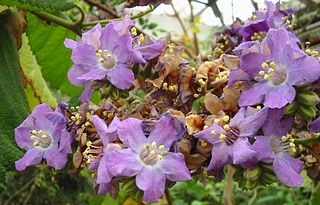
Wigandia is a genus of flowering plants within the waterleaf subfamily, Hydrophylloideae. They are found mainly in Central America and South America, though one or two species are found as far north as the United States. Some are grown as ornamental plants and will flourish in most Mediterranean or temperate regions. The genus is named for Johann Wigand, German Lutheran cleric and theologian, and Bishop of Pomesania.
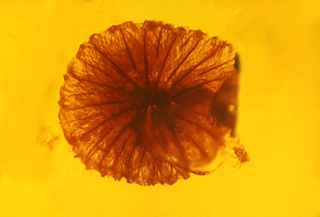
Coprinites is an extinct monotypic genus of gilled fungus in the Agaricales family Agaricaceae. At present it contains the single species Coprinites dominicana.
Aureofungus is an extinct monotypic genus of gilled fungus in the order Agaricales. At present it contains the single species Aureofungus yaniguaensis.
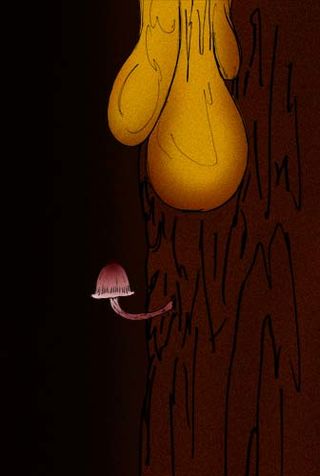
Protomycena is an extinct monotypic genus of gilled fungus in the family Mycenaceae, of order Agaricales. At present it contains the single species Protomycena electra, known from a single specimen collected in an amber mine in the Cordillera Septentrional area of the Dominican Republic. The fruit body of the fungus has a convex cap that is 5 mm (0.2 in) in diameter, with distantly spaced gills on the underside. The curved stipe is smooth and cylindrical, measuring 0.75 mm (0.030 in) thick by 10 mm (0.39 in) long, and lacks a ring. It resembles extant species of the genus Mycena. Protomycena is one of only five known agaric fungus species known in the fossil record and the second to be described from Dominican amber.
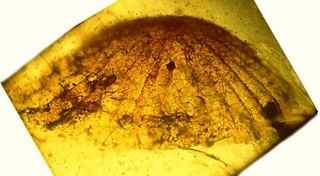
Palaeoagaracites is an extinct monotypic genus of gilled fungus in the order Agaricales. It contains the single species Palaeoagaracites antiquus.

Suillus salmonicolor, commonly known as the Slippery Jill, is a fungus in the family Suillaceae of the order Boletales. First described as a member of the genus Boletus in 1874, the species acquired several synonyms, including Suillus pinorigidus and Suillus subluteus, before it was assigned its current binomial name in 1983. It has not been determined with certainty whether S. salmonicolor is distinct from the species S. cothurnatus, described by Rolf Singer in 1945. S. salmonicolor is a mycorrhizal fungus—meaning it forms a symbiotic association with the roots of plants such that both organisms benefit from the exchange of nutrients. This symbiosis occurs with various species of pine, and the fruit bodies of the fungus appear scattered or in groups on the ground near the trees. The fungus is found in North America, Hawaii, Asia, the Caribbean, South Africa, Australia and Central America. It has been introduced to several of those locations via transplanted trees.

Sporobolomyces is a genus of fungi in the subdivision Pucciniomycotina. Species produce both yeast states and hyphal states. The latter form teliospores from which auricularioid (tubular and laterally septate) basidia emerge, bearing basidiospores. Yeast colonies are salmon-pink to red. Sporobolomyces species occur worldwide and have been isolated (as yeasts) from a wide variety of substrates. They produce ballistoconidia that are bilaterally symmetrical, they have Coenzyme Q10 or Coenzyme Q10(H2) as their major ubiquinone, they lack xylose in whole-cell hydrolysates, and they cannot ferment sugars. One species, Sporobolomyces salmonicolor, is known to cause disease in humans.
Apterostigma electropilosum is an extinct species of ant in the subfamily Myrmicinae known from a single possibly Miocene fossil found on Hispaniola. A. electropilosum is one of only two species of the ant genus Apterostigma and one of five attini species to have been described from fossils found in Dominican amber.

Sporobolomyces salmonicolor is a species of fungus in the subdivision Pucciniomycotina. It occurs in both a yeast state and a hyphal state, the latter formerly known as Sporidiobolus salmonicolor. It is generally considered a Biosafety Risk Group 1 fungus; however isolates of S. salmonicolor have been recovered from cerebrospinal fluid, infected skin, a nasal polyp, lymphadenitis and a case of endophthalmitis. It has also been reported in AIDS-related infections. The fungus exists predominantly in the anamorphic (asexual) state as a unicellular, haploid yeast yet this species can sometimes produce a teleomorphic (sexual) state when conjugation of compatible yeast cells occurs. The asexual form consists of a characteristic, pink, ballistosporic yeast. Ballistoconidia are borne from slender extensions of the cell known as sterigmata and are forcibly ejected into the air upon maturity. Levels of airborne yeast cells peak during the night and are abundant in areas of decaying leaves and grains. Three varieties of Sporobolomyces salmonicolor have been described; S. salmonicolor var. albus, S. salmonicolor var. fischerii, and S. salmonicolor var. salmoneus.
References
- ↑ Lumbsch TH, Huhndorf SM (December 2007). "Outline of Ascomycota – 2007". Myconet. Chicago, USA: The Field Museum, Department of Botany. 13: 1–58. Archived from the original on March 18, 2009. Retrieved 2009-12-05.
- ↑ Angelini C, Medardi G, Alvarado P (March 8, 2018). "Contribution to the study of neotropical discomycetes: a new species of the genus Geodina (Geodina salmonicolor sp. nov.) from the Dominican Republic" (PDF). Mycosphere. Guiyang, CN: Guizhou Academy of Agricultural Sciences, Department of Botany. 9 (2): 169–177.